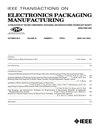Design Envelopes and Optical Feature Extraction Techniques for Survivability of SnAg Lead-free Packaging Architectures Under Shock and Vibration
IEEE Transactions on Electronics Packaging Manufacturing
Pub Date : 2008-05-27
DOI:10.1109/TEPM.2009.2031873
引用次数: 46
Abstract
In this paper, a design-envelope approach based on optical feature extraction techniques has been investigated for drop and shock survivability of electronic packaging has been presented for 6-lead-free solder alloy systems. Solder alloy systems investigated include, Sn1Ag0.5Cu, Sn3Ag0.5Cu, Sn0.3Ag0.7Cu, Sn0.3Ag0.7Cu0.1Bi, Sn0.2Ag0.7Cu0.1Bi-0.1Ni, 96.5Sn 3.5Ag. Previously, digital image correlation (DIC) has been used for measurement of thermally induced deformation and material-characterization. In this paper, DIC has been used for transient dynamic measurements, and optical feature extraction. Board assemblies have been subjected to shock-impact in various orientations including the JEDEC zero-degree drop and the vertical free-drop. Transient deformation has been measured using both digital image correlation and the strain gages. Measurements have been taken on both the package and the board side of the assemblies. Accuracy of high-speed optical measurement has been compared with that from discrete strain gages. Package architectures examined include-flex ball-grid arrays, tape-array ball-grid arrays, and metal lead-frame packages. Explicit finite-element models have been developed and correlated with experimental data. Models developed include, smeared property models, and Timoshenko-beam models. The potential of damage identification and tracking for various solder alloys has been investigated. Data on identification of damage proxies for competing failure mechanisms at the copper-to-solder, solder-to-printed circuit board, and copper-to-package substrate has been presented. Design envelopes have been developed based on statistical pattern recognition. The design-envelope is intended for component integration to ensure survivability in shock and vibration environments at a user-specified confidence level.冲击和振动下无铅铅封装结构的设计封装和光学特征提取技术
本文研究了一种基于光学特征提取技术的包络设计方法,提出了一种用于6无铅焊料合金系统的电子封装的跌落和冲击生存性。研究的钎料合金体系包括:Sn1Ag0.5Cu、Sn3Ag0.5Cu、Sn0.3Ag0.7Cu、Sn0.3Ag0.7Cu0.1Bi、Sn0.2Ag0.7Cu0.1Bi-0.1Ni、96.5Sn 3.5Ag。以前,数字图像相关(DIC)已被用于测量热致变形和材料表征。在本文中,DIC被用于瞬态动态测量和光学特征提取。板组件已经受到冲击冲击在不同的方向,包括JEDEC零度下降和垂直自由落体。利用数字图像相关和应变片测量了瞬态变形。对组件的封装和板侧都进行了测量。比较了高速光学测量与离散应变片测量的精度。研究的封装架构包括柔性球栅阵列、磁带阵列球栅阵列和金属引线框架封装。建立了显式有限元模型,并与实验数据相关联。开发的模型包括涂抹属性模型和Timoshenko-beam模型。研究了各种钎料合金损伤识别和跟踪的潜力。在铜到焊料、焊料到印刷电路板和铜到封装基板的竞争失效机制的损伤代理识别数据已经提出。设计信封是基于统计模式识别开发的。设计外壳用于组件集成,以确保在用户指定的置信度下在冲击和振动环境中的生存能力。
本文章由计算机程序翻译,如有差异,请以英文原文为准。
求助全文
约1分钟内获得全文
求助全文

 求助内容:
求助内容: 应助结果提醒方式:
应助结果提醒方式:


